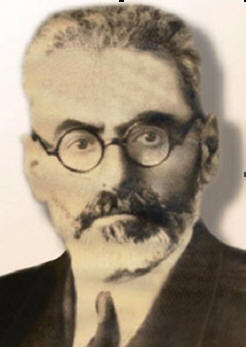
Born in 1889, Azizollah Naeem was a community leader dedicated to revitalizing Jewish cultural life in Iran. From founding Hebrew night classes to advising the Jewish Renaissance Movement, Naeem’s legacy includes cultural, educational, and social reforms that strengthened the Iranian Jewish community. This article explores the life of Rabbi Naeem who spent a lifetime serving the Jewish community worldwide.
Early Life and Education
Azizollah Naeem, the son of Yonah and Tamar, was born in 1889 in Damavand, Iran. He began his education at the newly established Alliance (Ettehad) School and, by the age of twenty, earned diplomas in Persian and French, immediately becoming active in cultural institutions. Naeem was fluent in Persian, Hebrew, Arabic, French, and English, which greatly enhanced his influence within the Jewish community.
Career and Community Involvement
Tehran Jewish Committee
Naeem was a prominent religious figure and intellectual during the late reign of Ahmad Shah Qajar and the early years of Reza Shah’s rule. He was known for his extensive knowledge of religious and cultural issues and was dedicated to advancing a civilized cultural society within the Jewish community. From the onset of his career, Naeem actively collaborated with the Tehran Jewish Committee (Hebra) and other cultural organizations, positioning himself as a supportive and guiding member.
The Jewish Youth Cultural Movement
Following the establishment of the Jewish Youth Cultural Movement in Tehran, led by Soleiman Cohensedgh, the movement aimed to revive the Hebrew language and tackle existing societal challenges. After numerous meetings, it was decided during the 20th session to invite Naeem, the son of Yonatan Damavandi, to join the movement to attract more young members. In a meeting held on Wednesday night, 24 Adar 5679 (March 26, 1910), Naeem was elected to join the Board of Directors and also act as the secretary of the sessions and was tasked with overseeing the movement’s cultural committee to further the education of young Jews.
Zionist Association of Iran
Shortly after the beginning of the second Pahlavi era, Naeem helped form the Brit Ivrit Olamit (World Hebrew Union). After some time, the movement’s board decided to rename itself the Zionist Association of Iran to foster connections with Jewish organizations in Europe and Jerusalem and to receive cultural and economic support from Jewish communities worldwide. The association was also trusted with revising all cultural and social issues of the Jewish community in Iran.
One of Naeem’s initial actions was to establish friendly ties with non-Sephardic Jews, notably fostering relations with those in Copenhagen. The association soon expanded, inviting Jewish groups from other Iranian cities to join and contribute to creating a progressive Jewish society. Upon receiving official recognition from the Iranian government, Naeem translated and published the history and statutes of the Jewish movement into Hebrew (using the Persian-Hebrew script).
In their 68th session, held in 1920 (5680 Hebrew Calendar), the association decided to launch a newspaper named ‘Organ-e Nehzat-e Yahud-e Iran’ (Organ of the Iranian Jewish Movement) to serve as the official voice of the Iranian Jewish movement. The newspaper was managed by Rabbi Naeem.
In 1920, twenty-five people were elected to manage the central organization and the Tehran branch, with the first three being Dr. Albo, Cohensedgh, and Azizollah Naeem. Naeem was appointed as the head of the organization, with Soleiman Cohensedgh leading the Tehran branch.
Marriage
In 1919, Naeem married Ghodrat Lahijani from the Lahijani family. The couple had one daughter, Betsion, and four sons: Bension, Amos, Dan, and Gad. Following his marriage, Rab Naeem set off for Europe.
Jewish Renaissance Movement
Rab Naeem was appointed as an advisor to the ‘Century of HaGeullah’ Association. According to the Encyclopaedia Judaica, in the Persia section, pages 218 and 219, this movement began under the leadership of Mr. Azizollah Naeem. The movement initially focused on promoting the Hebrew language, and Rab Naeem, as part of his cultural and social efforts, translated the history of the global Zionist movement for the first time. He published it in Persian using Hebrew letters (Farsi-Hebrew) in the HaGeullah newspaper. Since he was planning to travel to Europe in 1921, he agreed to represent the Jewish Movement of Iran at the Thirteenth Congress.
Managed by Rab Naeem, Organ-e Nehzat-e Yahud-e Iran newspaper voiced the aspirations of the Jewish Renaissance Movement in Iran. Later, extensive works of poetry by Bialik, a Jewish poet, were translated by Azizollah Naeem and published in the newspaper.
Return to Iran
Before leaving
After his marriage, Rab Naeem moved to Europe, where he lived in France and England for over seven years, continuing his studies. Notably, during his time in Iran, he was a skilled employee at the Bank of Iran and England and served as an official translator for the newspaper ‘Ra’d’, owned by Seyyed Zia ol Din.
Marriage and divorce office
After spending over seven years in France and England to further his studies, Naeem returned to Iran and resumed his role as a religious leader. He obtained a legal license to establish a marriage and divorce registry (Office No. 38) in Tehran, and he collaborated frequently with Mirza Mousa Khan Toob to address community issues and engage in public welfare initiatives.
Hebrew night classes
Mirza Musa Khan was impressed by the intelligence, talent, and knowledge of Rabbi Naeem, often supporting him in his charitable work. After founding the Cyrus School, evening classes for Hebrew language learning were introduced, where Rab Naeem personally taught Hebrew and religious studies.
Papers, schools, and translation
Rabbi Naeem played a significant role in assisting Dr. Rahim Cohen, the editor of ‘The World of Jews’, with the newspaper’s publication. He also managed the House of Jewish Culture and Literature for a period. As a pioneer, he established primary schools using European teaching methods and served for many years as an official translator for the Ministry of Justice in Hebrew, French, and English.
First community ballot box
Towards the end of World War II, Rab Naeem, a prominent religious leader with deep knowledge, took significant steps to organize the social activities of Iranian Jews. In 1945, he set up the first election ballot box at the Ettehad School in Jaleh street, taking the initial step to form a community-elected cultural association.
Researching community challenges
Rab Naeem also took it upon himself to address the community’s challenges. He personally investigated the dire conditions of impoverished Jews, who made up much of the community, especially during the war. In a 1942 report, he vividly documented the social and cultural conditions, issues with nutrition and health, such as the typhus outbreak in the Oudlajan neighborhood, the spread of infectious diseases, the lack of medicine in hospitals, and other critical shortages, including the need for clean drinking water in Oudlajan and other community problems.
Attending to Polish refugees
Rab Naeem prepared a report to support Polish Jewish refugees who had migrated to Iran during the war. The report addressed the needs of Polish patients, arranged housing for over one hundred orphaned Polish children, and provided support to more than eighty Bukharian Jewish families living in Iran. He presented this report to the Hebra (the Jewish Committee) and the Iranian Jewish Youth Movement, and also sent a copy to the royal court, requesting government assistance.
Supreme Society of Science and Literature
Scholars in the Jewish community have noted Rab Naeem’s contributions. National poet Abdullah Taleh Hamadani wrote that Rab Naeem was an active member of the Supreme Society of Science and Literature in Tehran, alongside prominent figures like Dr. Reza Zadeh Shafagh, Rashid Yasami, Saeed Nafisi, and other intellectuals. The society was occasionally visited by French cultural figures and diplomats, particularly from the Iran-France Cultural Association. Every 15 days, a researcher spoke on various topics. When it was Rab Naeem’s turn, he delivered a fluent and impactful speech in French about the Alliance Israélite and the history of Jews in Iran. His speech received a warm response and the French ambassador, who also led the Iran-France Cultural Association, stood up, embraced Rab Naim, and said, ‘Your speech deeply moved me, especially your exceptional mastery of the French language. It’s truly admirable.’
German Jewish asylum seekers
In the early years of the Nazi regime in Germany, many German Jews fled to France, including numerous specialists, engineers, and doctors seeking to work in Iran. Lists of their names and expertise were sent through Iranian ambassadors in Europe and Turkey to the Ministry of Foreign Affairs and Reza Shah’s private office. During this time, Rab Naeem was in France. In 1931, he sent a detailed letter to the Ministry of the Court proposing that these German Jewish professionals in Paris be employed to serve Iran and contribute to its development. Although the government initially showed interest, changing circumstances and policies eventually led to delays and the rejection of the proposal.
Death
Rabbi Azizollah Naeem passed away on November 16, 1946 at the age of 57 due to heart disease. His funeral, held by the Jewish Committee, was attended by over five thousand people.
Works of Azizollah Naeem
Books and translations
- Commentary and Analysis of the Philosophy of Rambam (Maimonides)
- The History and Philosophy of Jewish Mysticism
- The First Textbook of Modern Hebrew
- Hebrew-Persian Dictionary
- Persian-Hebrew and Hebrew-Persian Dictionary (both volumes were used by Haim in his works, though Naeem was not credited).
- Translation of Bialik’s Poems
- Translation of Theodor Herzl’s Book on Jews and His Biography by Bein
- Translation of the History of the Zionist Movement
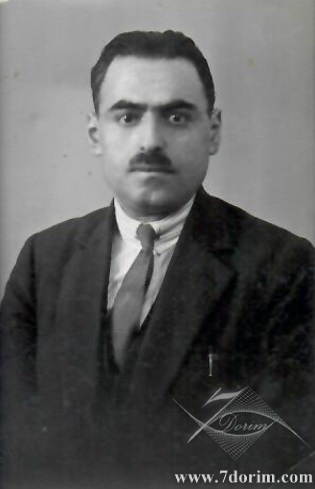
Rabbi Azizollah Naeem, 1889 -1946.
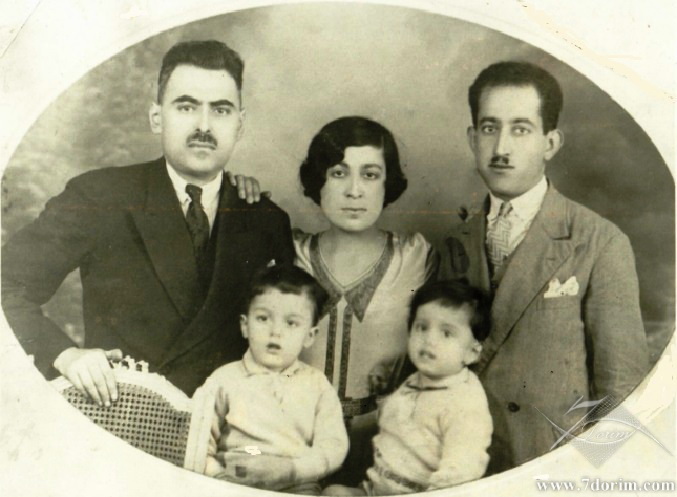
Image of Azizollah Naeem’s family in Paris, 1932. From right: Habib Lahijani, Ghodrat Lahijani (Naeem), Azizollah Naeem, Dan Naeem, Amos Naeem.
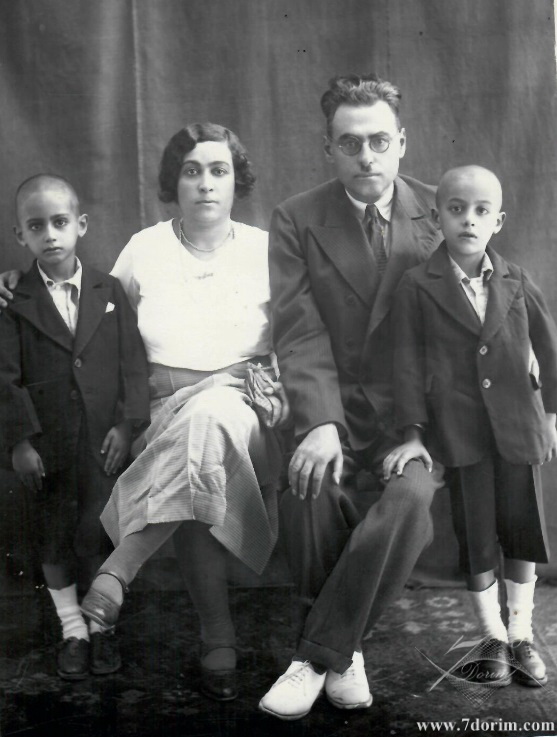
Image of Azizollah Naeem’s family in Paris, 1936. From right: Amos Naeem, Azizollah Naeem, Ghodrat Lahijani, Dan Naeem.
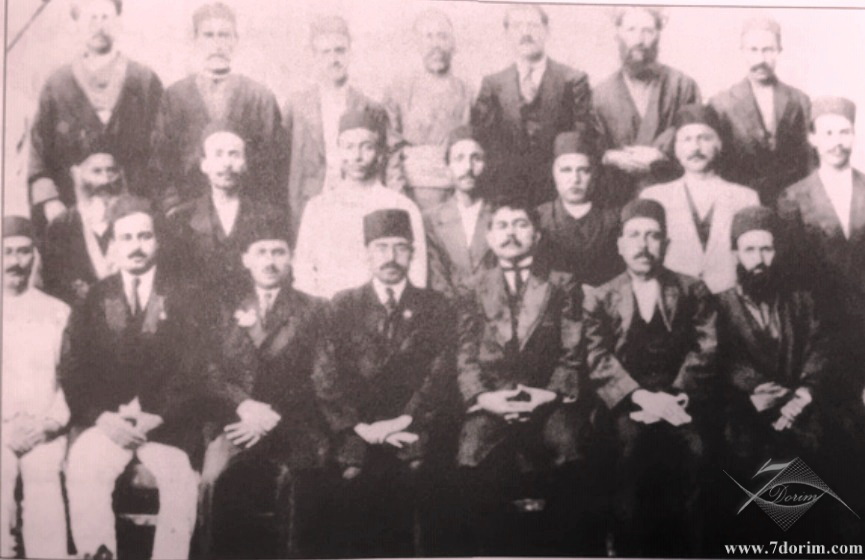
Rabbi Azizollah Naeem visits the Kermanshah Jewish Hebra on behaf of the Tehran Committee, 1920. From Left: Haji Elazar, Abdullah Hakimzadeh, Soleiman Kashani, Rab Naeem, Head of Alliance School, Meir Hajiyosef, Mollah Abram.
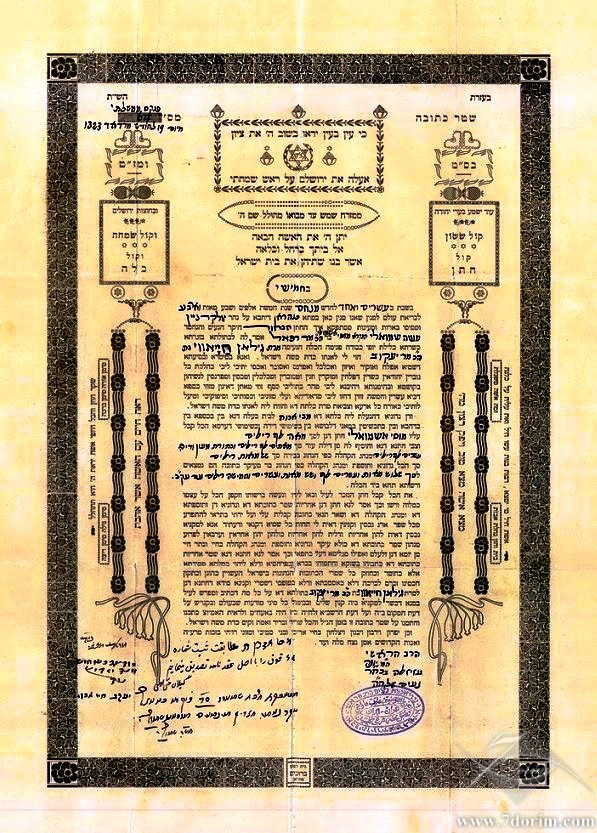
A Ketuba (Jewish marriage contract) registered in the 1940s by the Marriage and Divorce Office Number 38 by Rabbi Naeem.
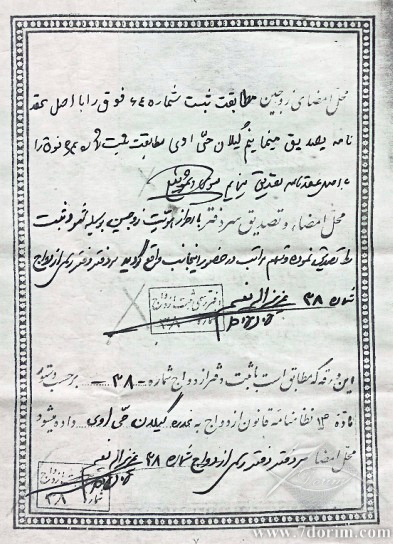
A page from a marriage contract registered in the Marriage and Divorce Office Number 38 by Rabbi Naeem.
Timeline of Key Events
1889: Born in Damavand, Iran.
1910: Joins the Jewish Youth Cultural Movement.
1919: Marries Ghodrat Lahijani; becomes head of the central organization and Tehran branch of the Jewish movement.
1920: Establishes the official newspaper of the Jewish Movement of Iran.
1921: Represents the Iranian Jewish Movement at the 13th Congress in Europe.
1943: Prepares a report on the social and cultural conditions of the Jewish community during World War II.
1945: Establishes the first electoral ballot box at the Ettehad School of Jaleh.
1946: Passes away due to heart disease.


 فارسی
فارسی